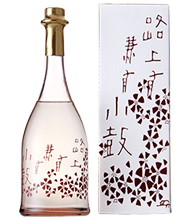Nishiyama Shuzo, Kotsuzumi Sake, Hyogo Prefecture, Tanba City
Thanks to images of Tokyo, Osaka and Kobe, Japan is often thought of as an urbanus landscape filled with sky scraping metropolises evoking thoughts of Blade Runner. However, its mountainous topography makes it rather rural, with plenty of countryside in which to hide quaint, remote places. Once such space in the high hills of Hyogo Prefecture houses Nishiyama Shuzo, home to Kotsuzumi Saké.
History
Established some 168 years ago, 1849 to be precise, Nishiyama is a classically modern Shuzo, respecting its history, whilst forging ahead in that unique way the Japanese have of blending tradition with modernity to achieve perfection. Its tradition is to use the pristine, soft-water of wells fed from the same aquifers which give life to the Takeda
River. On site wells insure that theirs is a saké of purity, power, and elegance.
Philosophy
Nishiyama wishes to share saké, an “honorable” apsect of Japanese culture, with the world, and is committed to
protecting their regionality by using only water from their own wells, locally grown rice, the majority of which hails from estate paddies, using rare, organically cultivated, heirloom rice like Tajima Goriki & Hyogo-kitanishiki. Also rather unique is their almost exclusive use of Ogawa #10 yeast strain. Additionally, they limit production to that which is sustainable, thus protecting their resources, heritage, and the outstanding quality of Kotsuzumi Saké.
Nishiyama Motto
Ours is a traditional business, yet we have persevered for nearly two centuries by being able to change with the times, whilst protecting our heritage. Protecting and “not changing” are incongruent with our goal to provide saké lovers with a saké that reflect our traditions while embracing progress, leaving them to comment, “This is totally new!”.
History of the Name
Hakuun Nishiyama was the third generation of the family to helm the shuzo and a haiku poet. In the early years of
the 20th century he immersed himself in the stimulating world of Meiji Era haiku, associating with renown poets Hakutsuki and Kyoshi. After enjoying some of Nishiyama’s saké in 1915, Kyoshi penned and read this haiku, whose beauty is lost in translation, aloud at the shuzo, thus giving a name to what he assuredly felt was an exceptional beverage;
“Here it is, the great Saké. It’s called Kotsuzumi,”




